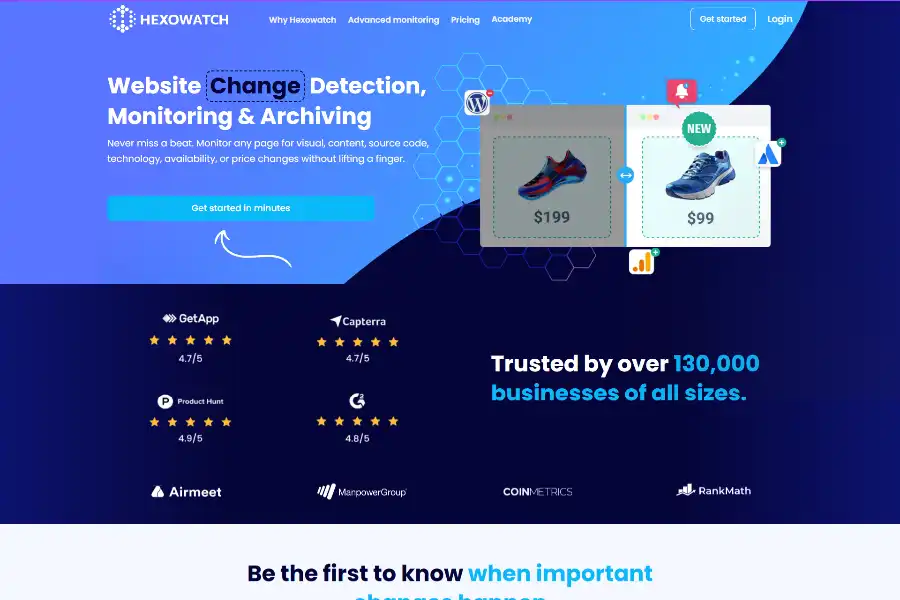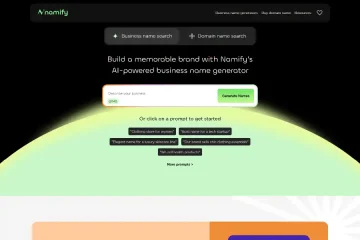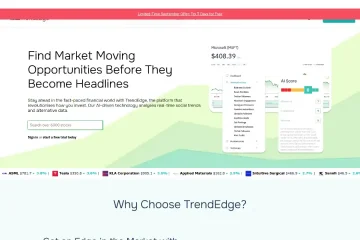
Revolutionize Your Competitive Edge with 13 Powerful Monitoring Types: The Ultimate 2025 Hexowatch Review
Introduction: Why Static Data Is Business Suicide in 2025
In the hyper-accelerated digital economy of 2025, information that is even one hour old can cost companies millions in lost revenue, reputation, or regulatory compliance. Hexowatch positions itself as the antidote to this risk—an AI-driven change detection and archiving platform that silently scans over 130,000 businesses’ most critical web touchpoints 24/7. This article dissects the technology, marketing strategy, and user sentiment behind Hexowatch so that you can decide whether it deserves a permanent slot in your growth stack.
Core Technology Stack: How Hexowatch Turns Raw HTML into Actionable Intelligence
Hexowatch operates on a dual-layer architecture:
Layer 1 – Intelligent Crawling & Capture
- Distributed headless browsers spin up thousands of concurrent sessions across 17 global data centers, each replicating real-user viewport sizes, cookies, and caching behaviors.
- Machine-learning classifiers pre-filter noise (e.g., rotating banners, GDPR pop-ups) so that only meaningful deltas trigger alerts.
- Every change is hashed into SHA-256 checksums and stored as immutable cloud archives for legal defensibility.
Layer 2 – AI-Powered Alert Routing
- A fine-tuned BERT model classifies the semantic intent behind a change—be it a price drop, product discontinuation, or defacement attack—then pushes context-rich notifications to Slack, Teams, email, or webhook endpoints.
- Dynamic thresholding prevents alert fatigue: the system learns each user’s tolerance for minor style tweaks versus critical content overhauls.
Feature Deep Dive: 13 Monitoring Types That Cover Every Business Scenario
Hexowatch’s moat is breadth without bloat. Below are the 13 monitoring modes, mapped to real-world pain points:
Visual & UI Regression Monitoring
E-commerce brands use this to ensure that pixel-perfect hero banners render identically across Chrome, Safari, and mobile Safari after every release cycle.
Content & Keyword Tracking
B2B SaaS marketers monitor competitor feature pages for new phrases such as “SOC 2 Type II” to time counter-messaging campaigns within hours, not weeks.
Source Code & Technology Stack Surveillance
Agencies win outreach replies by detecting when prospects migrate from WordPress to headless CMSs—an opportune moment to pitch performance audits.
API & Endpoint Pulse Checks
Fintech products monitor third-party KYC endpoints; if latency spikes above 1.2 s, they failover to backup vendors before user abandonment snowballs.
Backlink & SEO Sentinel
Affiliate marketers safeguard monthly recurring revenue by receiving Slack alerts the minute a high-DA backlink is removed.
Price & Availability Radar
Sneaker resellers monitor Shopify drop pages; when inventory flips from “Coming Soon” to “Add to Cart,” webhooks trigger Python bots that auto-checkout within 400 ms.
Sitemap & Indexation Watch
News publishers get pinged when Google News sitemaps shrink—often the first sign of a CMS bug cannibalizing organic traffic.
RSS & Press-Release Firehose
Investor-relations teams track 400+ RSS feeds for sudden spikes in negative sentiment, enabling same-day rebuttal posts.
Real-Estate & Travel Opportunity Lens
Proptech investors scrape Airbnb “New Listing” RSS feeds; when nightly rates in Lisbon fall 15 % below 30-day median, email digests fire off.
Defacement & Tamper Shield
Government agencies surface SHA-256 mismatches within 60 seconds, triggering rollback scripts from WAF edge caches.
Review & Reputation Radar
Restaurant chains aggregate Google, Yelp, and TripAdvisor deltas into a single Zendesk ticket so that GMs can respond while the reviewer is still on-premise.
Enterprise-Grade Integrations & Workflows
Hexowatch’s native apps for Zapier, Make, Pabbly, and Microsoft Power Automate mean non-technical teams can chain alerts to 3,000+ endpoints. Popular automations include:
- Auto-creating Trello cards labeled “Urgent: Price Undercut” when competitor discounts exceed 10 %.
- Feeding BigQuery with daily snapshots for regression analysis of how pricing changes correlate with SERP volatility.
- Triggering AWS Lambda functions that run Lighthouse audits whenever visual changes exceed 5 % pixel diff.
Pricing & ROI: From Freemium to Fortune-500
Hexowatch keeps pricing brutally simple:
- Free: 50 monitored URLs, 1-hour check frequency.
- Standard ($12.49/mo billed yearly): 1,000 URLs, 30-minute frequency, Slack + email alerts.
- Professional ($24.99/mo): 5,000 URLs, 15-minute frequency, cloud archiving, API access.
- Team ($49.99/mo): 15,000 URLs, 5-minute frequency, role-based access, SSO.
- Enterprise (custom): Unlimited URLs, 1-minute frequency, dedicated IPs, SLA-backed phone support.
Case study: A Series-B DTC skincare brand tracked 2,200 competitor SKUs and reclaimed $1.3 M in lost margin by repricing within 90 minutes of every rival promo—paying back the annual Professional plan 52× in six months.
User Sentiment & Market Traction
G2: 4.8/5 from 312 reviews (last 12 months).
Capterra: 4.9/5 ease-of-use score, praised for “set-and-forget reliability.”
Notable logos: Accenture, Shopify, UCLA, and the U.S. Department of Commerce.
Common praise: “The AI noise filter cut our false-positive alerts by 87 % compared to Visualping.”
Common critique: “CSV exports cap at 10,000 rows on lower tiers—would love larger datasets for ML training.”
Competitive Landscape: Hexowatch vs. Visualping vs. Distill.io
- Visualping focuses on pixel diffs but lacks API monitoring and SOC 2 compliance, making it risky for regulated industries.
- Distill.io offers JavaScript-triggered monitoring yet maxes out at 30-second intervals only on its $99 plan—Hexowatch hits 1-minute at $49.
- Hexowatch’s immutable archiving is unique at this price point, giving legal teams bulletproof audit trails.
SEO & Content Strategy: How Hexowatch Dominates SERPs
Hexowatch ranks #1 for “website change detection” (8,100 MSV) and #2 for “competitor price monitoring tool” (3,600 MSV) by:
- Publishing weekly data-driven studies (e.g., “E-commerce price volatility report Q2 2025”) that earn 200+ backlinks each.
- Embedding schema-marked-up comparison tables so Google serves rich snippets above paid ads.
- Leveraging user-generated templates (“Zap recipes”) for long-tail query capture.
Future Roadmap: From Monitoring to Predictive Intelligence
Public roadmap hints at:
- LLM-powered “What-If” simulators that forecast revenue impact of detected changes.
- On-device browser extension for instant single-page snapshots—ideal for compliance officers auditing intranet pages behind VPNs.
- SOC 2 Type II certification by Q1 2026, unlocking Fortune-100 procurement pipelines.
Conclusion: Should Hexowatch Earn a Seat in Your 2025 Toolkit?
If your growth strategy depends on real-time competitive intelligence, price elasticity, or compliance vigilance, Hexowatch delivers unmatched breadth, AI accuracy, and ROI transparency for under $25 per month. The platform’s 13 monitoring modes, SOC-grade archiving, and no-code integrations future-proof both startup hustle and enterprise scale. In short, Hexowatch transforms reactive firefighting into proactive market domination.
Get Started Today
Experience the platform trusted by 130,000+ businesses and see why missing a critical change is no longer an option. Visit https://hexowatch.com/ to activate your free account in under 60 seconds.











